Quilotoa Loop
Bare with us, this one is long....
Checked into Residencial Santiago, and after a wicked bowl of self-made potato, carrot, broccoli stew, we set in for a nice sleep.... or so we thought. Apparently people in Ecuador check into their hotels at 6:30am and make lots of noise doing it. We had thought we might sleep in for once, but after the couple yacking about the washrooms outside our door, and a group of men turing their TV up really loud and leaving their door open, we gave up and went in search of some breakfast at the nearby market. Some delicious fruit smoothies, and a few Pan de Chocolate later and we were good to go.
 We hopped on a bus headed for the town of Zumbahua. The bus started out empty save us and a few other passengers, but soon after leaving the terminal every seat was full. It wasn´t long before the aisles were packed with bags of potatos, chickens and people. I don´t think they have a work for Safety Hazard in Ecuador. It´s all "part of the experience" though right? Sarah rode most of the ride with someone´s child in her lap.
We hopped on a bus headed for the town of Zumbahua. The bus started out empty save us and a few other passengers, but soon after leaving the terminal every seat was full. It wasn´t long before the aisles were packed with bags of potatos, chickens and people. I don´t think they have a work for Safety Hazard in Ecuador. It´s all "part of the experience" though right? Sarah rode most of the ride with someone´s child in her lap.
About midway we jumped off the bus to check out some local indigenous art, known worldly as Tigua Art. It´s very colourful and depicts lots of landscape and traditional themes. We caved and bought a few pieces, but the real gems were the masks, some as big as the Regatta Turtle Shell at camp, or near a metre big for those non-campers. They were really cool, demons and local animals, and the biggest ones only fetched $50 or so. I wanted one badly but realistically carrying around a giant mask isn´t very fun.
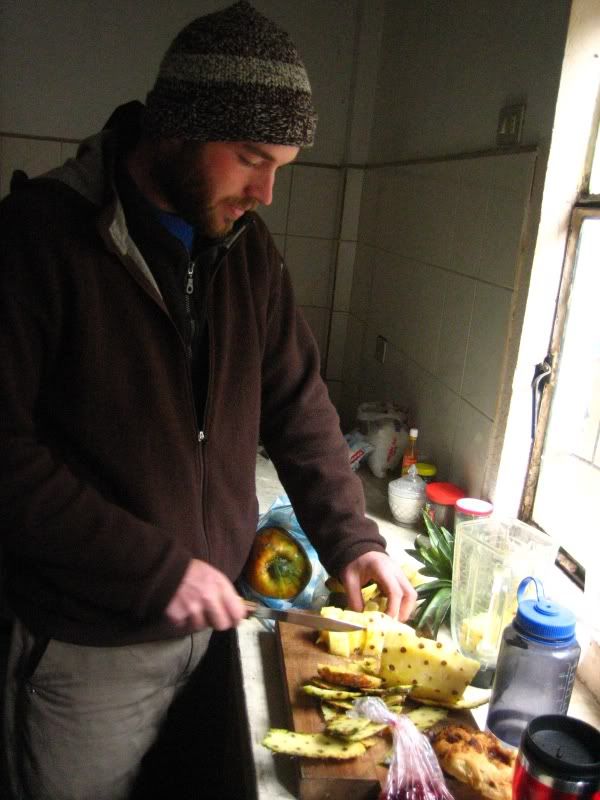
Catching the next bus and arriving in Zumbahua later that day, we were expecting a bit of a party night. Our guide book stated that "on Friday Zumbahua is hopping with tradition Andean music and dance. The night involves heavy drinking and sometimes spills over into the saturday market". Well the guide book was wrong, and the only people up for a party last friday was a small group of scraggy backpackers. Somewhat disapointed we went to bed in our Hostal, across from an empty Plaza. The next morning around 6:30 (again) music and loudspeakers were going off full blast, and we peered from our window to a Plaza now teeming with activity. Everyone had setup shop overnight and you could buy pretty much anything you needed. We picked up some fresh fruit and lunch stuff, and sat on the balcony overlooking the Plaza drinking our fruit smoothies. Some boys were all setup along a wall with their shoe shining kits, once corner was dominated by banannas. Here, you can buy small bananas, regular bananas, large bananas, green plantains, yellow plantains, large red bananas... and that´s just the fresh ones... they fry 'em, mash 'em, grill 'em... it´s quite impressive.
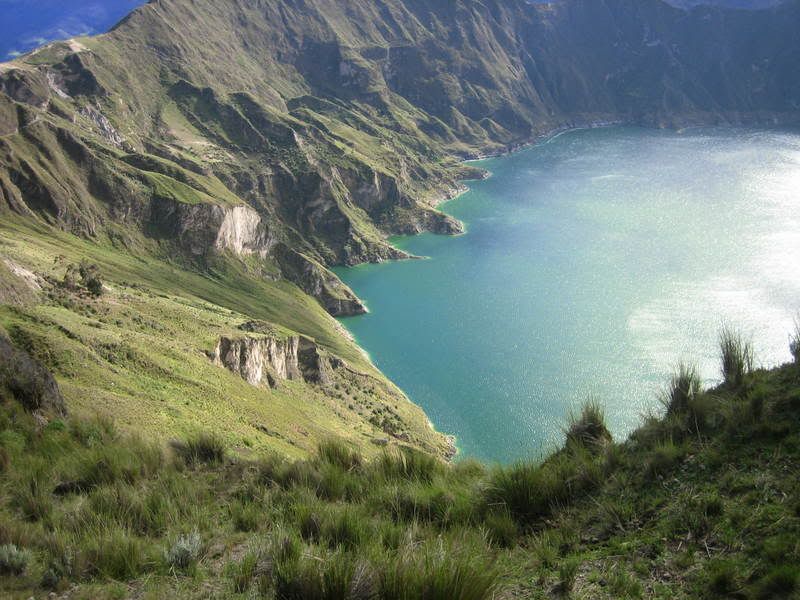 We walked around the market a bit more, then caught a bus to our next destination, Laguna Quilotoa. On our way to the bus we passed a few Camionetas which are basically pickup trucks that let you ride in the back for some money. They are pretty common way to get around to places that busses don´t go, or run more frequently than busses. The only problem is that they cost $5 a person, wheras the bus that is just about to leave only costs $0.50. We ran and caught the bus before it completely left and piled into it with all our stuff. Relegated to standing in the aisle straddling our packs, we got dropped off about 10 minute walk from our actual destination. Oh well. We paid less and we metup with two other girls that were heading to see the Laguna too.
We walked around the market a bit more, then caught a bus to our next destination, Laguna Quilotoa. On our way to the bus we passed a few Camionetas which are basically pickup trucks that let you ride in the back for some money. They are pretty common way to get around to places that busses don´t go, or run more frequently than busses. The only problem is that they cost $5 a person, wheras the bus that is just about to leave only costs $0.50. We ran and caught the bus before it completely left and piled into it with all our stuff. Relegated to standing in the aisle straddling our packs, we got dropped off about 10 minute walk from our actual destination. Oh well. We paid less and we metup with two other girls that were heading to see the Laguna too.
Laguna Quilotoa is a volcanic Lake that sits 400m down in the crater. It´s pretty impressive view from the top, looking down into the emerald green water. There is a small town that has been created because of tourism at the Laguna, so we checkout out the community run hostal and unloaded our bags. We joined up with the two other girls and braved the 30 minute hike down to the lake. At the bottom we ate some lunch and watched as some people rented boats to explore the lake. Some bright entrepreneur had lugged some sit on top kayaks and a small zodiac down and was offering them up at $5 a pop. We settled for a look around, and even touched the very alkaline water. They say you shouldn´t drink the water, and the fact that it was slimey solidified that notion in my mind. Now hiking 400m down isn´t the same as hiking 400m up... two hours or so later we arrived back up at the top and at our hostal. Some of the locals have setup stands right on the crater rim lookout, and were selling local handmade goods. It was pretty chilly, and all the sweaters and hats looked really nice. I caved and bought a pretty nice wool zip-up hoodie for $15 bucks. I know people have bought stuff for less here, and I didn´t even have to bargain her down, she dropped the price pretty quickly, but I was happy to pay $15 for something I´d have trouble finding handmade in canada for less than $80. The community hostal I mentioned before is run by a group of people in the community and all the proceeds generated are put back into the little village. It was a nice quaint little place, and we were the only people staying there. Breakfast and dinner were included in the $8 a night, so we relaxed and enjoyed some 'typical' ecuadorian fare.
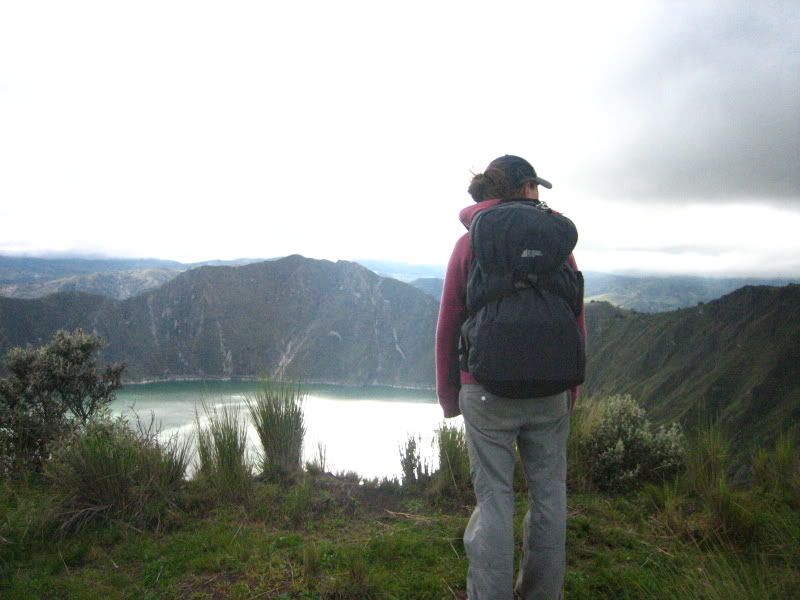
The next morning we woke up and set out on our big hike. We had planned to hike to the next village, which was about 20km away. The hike starts out going around the laguna crater rim and then drops off about a third of the way around and heads down to the small village of Guayana down into a very large canyon, and then back up the other side to the town of Chugchillan. Everything started out great and we made it around the rim to the designated spot. But soon after leaving the crater, the paths started splitting up and getting smaller and smaller. Signs that a local hostal had put up were conveinently removed by prospective guides, making us wish we weren't too cheap to hire one. After and hour of being 'lost' we eventually found the trail with the help of some farmers and made it the rest of the way allright. The hike was amazing, dropping into a giant canyon on a path that starts out like a tunnel. Lots of sketchy bridges and barking dogs to keep us on our toes, and the last hour is straight up the canyon to the finish line. Definitely a highlight of our trip so far.
The next day we decided to head up to a nearby cheese factory, and made the trek with another couple (from Belgium) and a Mother-Daughter team. We all are staying at the same hostal and thought it would be a good idea to hit the cheese factory up for so me cheese together, since they only sold in large quantities. The hike there was great, with some spectacular views across the canyon valley and over the next ridge to the Iliniza North and South Volcanoes that were dusted with snow. We had a map provided by the hostal that had instructions in english, unfortunately the drawn map didnt match the instructions and the six of us ended up walking down a wrong road for an hour or so. That hour down meant about two hours back up, so what started out as a nice 4 hour easy hike turned into a 9 hour epic on the back roads of Ecuador. Two for two, on our hikes so far. The rest of our time in Chugchillan we spent recouperating and relaxing.
me cheese together, since they only sold in large quantities. The hike there was great, with some spectacular views across the canyon valley and over the next ridge to the Iliniza North and South Volcanoes that were dusted with snow. We had a map provided by the hostal that had instructions in english, unfortunately the drawn map didnt match the instructions and the six of us ended up walking down a wrong road for an hour or so. That hour down meant about two hours back up, so what started out as a nice 4 hour easy hike turned into a 9 hour epic on the back roads of Ecuador. Two for two, on our hikes so far. The rest of our time in Chugchillan we spent recouperating and relaxing.
One reason Chugchillan and even the Quilotoa Loop are popular now is because of the Black Sheep Inn. The Inn is a Eco friendly hotel type place that is practicing Permaculture and sustainable practices, aswell as community development in the area. It´s owned by an American couple and they have done a really impressive job of realizing their goal and developping the community in a positive way. Most of the families around the area work as farmers and the land they cultivate is incredibly steep. A major problem is land and soil erosion and deforestation due to farming. It can be depressing seeing the never ending hills carpeted with farm after farm. On our hikes we've been seeing the families tilling the 45 degree incline fields by hand, and we know that sooner or later their land will just wash away. The Inn has been trying to help through education and demonstrating sustainable organic agriculture and permaculture, so perhaps change will happen. It's interesting to think that hundreds of years ago the Inca, who farmed the same slopes, practiced sustainable methods through terracing and natural fertalizer, but their decendants don't know how to.
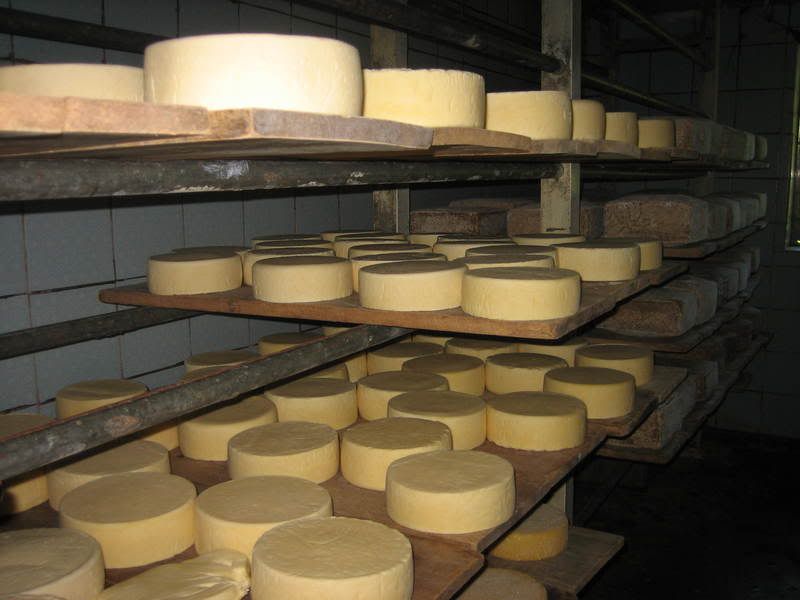
We decided to splurge for one of our nights in Chugchillan and stay at the Inn, since it costs a little more. Last night we relaxed by the woodstove, drinking tea, eating brownies and even broke out the guitar they had there. It was a good experience and a place that shouldn't be missed if you ever come down here.
This morning we woke up super early to catch the 3am bus. Getting to Chugchillan is easy, but getting away seems to be an early affair no matter how you work it. The only busses out of the town are at 3am and 4am, or you can hop on the milk truck at 9am and catch a bus in the next town. The 3am bus fit our schedule best, so we rolled out of bed and down to the road. We wanted to get to the town of Saqusili for their big market early. We rolled into town just after 7am and lugged our packs down from the roof of the bus. We had caught the bus with another lady from the Inn but unfortunately her bag, which was on the roof right beside ours, must have fallen off at some point on the bumpy ride. The bus took no responsibility for it, claiming someone must have stolen it. SOL as they say... we will certainly remember to go up and personally clip our packs to the rack in the future.
 The Saqusili Market is amazing. You can buy anything there from used tires, used clothings, water guns, ornate wooden cross tombstones, shoes, knives, crafts, woolen goods, art, fruit, veggies, grains, spices, illegal music and dvds, live pigs, goats, horses, cows, sheep, llamas, chickens, donkeys, raw wool.... i could go on. It was great. We spent a few hours wandering around and bought some breakfast fruit which we had pureed at a roadside stand into a smoothie. The best part was the animal market that was full of screaming pigs, angry cows, and hundreds of locals barganing and dragging their new bought sheep through the town. I took some recordings of it and will try to post them in the next few days.
The Saqusili Market is amazing. You can buy anything there from used tires, used clothings, water guns, ornate wooden cross tombstones, shoes, knives, crafts, woolen goods, art, fruit, veggies, grains, spices, illegal music and dvds, live pigs, goats, horses, cows, sheep, llamas, chickens, donkeys, raw wool.... i could go on. It was great. We spent a few hours wandering around and bought some breakfast fruit which we had pureed at a roadside stand into a smoothie. The best part was the animal market that was full of screaming pigs, angry cows, and hundreds of locals barganing and dragging their new bought sheep through the town. I took some recordings of it and will try to post them in the next few days.
We left Saqusili and caught two more buses to get us down here to Banos. Spend a few days here relaxing in the volcanic baths (el banos), and go for a bike ride perhaps!
Checked into Residencial Santiago, and after a wicked bowl of self-made potato, carrot, broccoli stew, we set in for a nice sleep.... or so we thought. Apparently people in Ecuador check into their hotels at 6:30am and make lots of noise doing it. We had thought we might sleep in for once, but after the couple yacking about the washrooms outside our door, and a group of men turing their TV up really loud and leaving their door open, we gave up and went in search of some breakfast at the nearby market. Some delicious fruit smoothies, and a few Pan de Chocolate later and we were good to go.
 We hopped on a bus headed for the town of Zumbahua. The bus started out empty save us and a few other passengers, but soon after leaving the terminal every seat was full. It wasn´t long before the aisles were packed with bags of potatos, chickens and people. I don´t think they have a work for Safety Hazard in Ecuador. It´s all "part of the experience" though right? Sarah rode most of the ride with someone´s child in her lap.
We hopped on a bus headed for the town of Zumbahua. The bus started out empty save us and a few other passengers, but soon after leaving the terminal every seat was full. It wasn´t long before the aisles were packed with bags of potatos, chickens and people. I don´t think they have a work for Safety Hazard in Ecuador. It´s all "part of the experience" though right? Sarah rode most of the ride with someone´s child in her lap.About midway we jumped off the bus to check out some local indigenous art, known worldly as Tigua Art. It´s very colourful and depicts lots of landscape and traditional themes. We caved and bought a few pieces, but the real gems were the masks, some as big as the Regatta Turtle Shell at camp, or near a metre big for those non-campers. They were really cool, demons and local animals, and the biggest ones only fetched $50 or so. I wanted one badly but realistically carrying around a giant mask isn´t very fun.

Catching the next bus and arriving in Zumbahua later that day, we were expecting a bit of a party night. Our guide book stated that "on Friday Zumbahua is hopping with tradition Andean music and dance. The night involves heavy drinking and sometimes spills over into the saturday market". Well the guide book was wrong, and the only people up for a party last friday was a small group of scraggy backpackers. Somewhat disapointed we went to bed in our Hostal, across from an empty Plaza. The next morning around 6:30 (again) music and loudspeakers were going off full blast, and we peered from our window to a Plaza now teeming with activity. Everyone had setup shop overnight and you could buy pretty much anything you needed. We picked up some fresh fruit and lunch stuff, and sat on the balcony overlooking the Plaza drinking our fruit smoothies. Some boys were all setup along a wall with their shoe shining kits, once corner was dominated by banannas. Here, you can buy small bananas, regular bananas, large bananas, green plantains, yellow plantains, large red bananas... and that´s just the fresh ones... they fry 'em, mash 'em, grill 'em... it´s quite impressive.
 We walked around the market a bit more, then caught a bus to our next destination, Laguna Quilotoa. On our way to the bus we passed a few Camionetas which are basically pickup trucks that let you ride in the back for some money. They are pretty common way to get around to places that busses don´t go, or run more frequently than busses. The only problem is that they cost $5 a person, wheras the bus that is just about to leave only costs $0.50. We ran and caught the bus before it completely left and piled into it with all our stuff. Relegated to standing in the aisle straddling our packs, we got dropped off about 10 minute walk from our actual destination. Oh well. We paid less and we metup with two other girls that were heading to see the Laguna too.
We walked around the market a bit more, then caught a bus to our next destination, Laguna Quilotoa. On our way to the bus we passed a few Camionetas which are basically pickup trucks that let you ride in the back for some money. They are pretty common way to get around to places that busses don´t go, or run more frequently than busses. The only problem is that they cost $5 a person, wheras the bus that is just about to leave only costs $0.50. We ran and caught the bus before it completely left and piled into it with all our stuff. Relegated to standing in the aisle straddling our packs, we got dropped off about 10 minute walk from our actual destination. Oh well. We paid less and we metup with two other girls that were heading to see the Laguna too.Laguna Quilotoa is a volcanic Lake that sits 400m down in the crater. It´s pretty impressive view from the top, looking down into the emerald green water. There is a small town that has been created because of tourism at the Laguna, so we checkout out the community run hostal and unloaded our bags. We joined up with the two other girls and braved the 30 minute hike down to the lake. At the bottom we ate some lunch and watched as some people rented boats to explore the lake. Some bright entrepreneur had lugged some sit on top kayaks and a small zodiac down and was offering them up at $5 a pop. We settled for a look around, and even touched the very alkaline water. They say you shouldn´t drink the water, and the fact that it was slimey solidified that notion in my mind. Now hiking 400m down isn´t the same as hiking 400m up... two hours or so later we arrived back up at the top and at our hostal. Some of the locals have setup stands right on the crater rim lookout, and were selling local handmade goods. It was pretty chilly, and all the sweaters and hats looked really nice. I caved and bought a pretty nice wool zip-up hoodie for $15 bucks. I know people have bought stuff for less here, and I didn´t even have to bargain her down, she dropped the price pretty quickly, but I was happy to pay $15 for something I´d have trouble finding handmade in canada for less than $80. The community hostal I mentioned before is run by a group of people in the community and all the proceeds generated are put back into the little village. It was a nice quaint little place, and we were the only people staying there. Breakfast and dinner were included in the $8 a night, so we relaxed and enjoyed some 'typical' ecuadorian fare.

The next morning we woke up and set out on our big hike. We had planned to hike to the next village, which was about 20km away. The hike starts out going around the laguna crater rim and then drops off about a third of the way around and heads down to the small village of Guayana down into a very large canyon, and then back up the other side to the town of Chugchillan. Everything started out great and we made it around the rim to the designated spot. But soon after leaving the crater, the paths started splitting up and getting smaller and smaller. Signs that a local hostal had put up were conveinently removed by prospective guides, making us wish we weren't too cheap to hire one. After and hour of being 'lost' we eventually found the trail with the help of some farmers and made it the rest of the way allright. The hike was amazing, dropping into a giant canyon on a path that starts out like a tunnel. Lots of sketchy bridges and barking dogs to keep us on our toes, and the last hour is straight up the canyon to the finish line. Definitely a highlight of our trip so far.
The next day we decided to head up to a nearby cheese factory, and made the trek with another couple (from Belgium) and a Mother-Daughter team. We all are staying at the same hostal and thought it would be a good idea to hit the cheese factory up for so
 me cheese together, since they only sold in large quantities. The hike there was great, with some spectacular views across the canyon valley and over the next ridge to the Iliniza North and South Volcanoes that were dusted with snow. We had a map provided by the hostal that had instructions in english, unfortunately the drawn map didnt match the instructions and the six of us ended up walking down a wrong road for an hour or so. That hour down meant about two hours back up, so what started out as a nice 4 hour easy hike turned into a 9 hour epic on the back roads of Ecuador. Two for two, on our hikes so far. The rest of our time in Chugchillan we spent recouperating and relaxing.
me cheese together, since they only sold in large quantities. The hike there was great, with some spectacular views across the canyon valley and over the next ridge to the Iliniza North and South Volcanoes that were dusted with snow. We had a map provided by the hostal that had instructions in english, unfortunately the drawn map didnt match the instructions and the six of us ended up walking down a wrong road for an hour or so. That hour down meant about two hours back up, so what started out as a nice 4 hour easy hike turned into a 9 hour epic on the back roads of Ecuador. Two for two, on our hikes so far. The rest of our time in Chugchillan we spent recouperating and relaxing.One reason Chugchillan and even the Quilotoa Loop are popular now is because of the Black Sheep Inn. The Inn is a Eco friendly hotel type place that is practicing Permaculture and sustainable practices, aswell as community development in the area. It´s owned by an American couple and they have done a really impressive job of realizing their goal and developping the community in a positive way. Most of the families around the area work as farmers and the land they cultivate is incredibly steep. A major problem is land and soil erosion and deforestation due to farming. It can be depressing seeing the never ending hills carpeted with farm after farm. On our hikes we've been seeing the families tilling the 45 degree incline fields by hand, and we know that sooner or later their land will just wash away. The Inn has been trying to help through education and demonstrating sustainable organic agriculture and permaculture, so perhaps change will happen. It's interesting to think that hundreds of years ago the Inca, who farmed the same slopes, practiced sustainable methods through terracing and natural fertalizer, but their decendants don't know how to.

We decided to splurge for one of our nights in Chugchillan and stay at the Inn, since it costs a little more. Last night we relaxed by the woodstove, drinking tea, eating brownies and even broke out the guitar they had there. It was a good experience and a place that shouldn't be missed if you ever come down here.
This morning we woke up super early to catch the 3am bus. Getting to Chugchillan is easy, but getting away seems to be an early affair no matter how you work it. The only busses out of the town are at 3am and 4am, or you can hop on the milk truck at 9am and catch a bus in the next town. The 3am bus fit our schedule best, so we rolled out of bed and down to the road. We wanted to get to the town of Saqusili for their big market early. We rolled into town just after 7am and lugged our packs down from the roof of the bus. We had caught the bus with another lady from the Inn but unfortunately her bag, which was on the roof right beside ours, must have fallen off at some point on the bumpy ride. The bus took no responsibility for it, claiming someone must have stolen it. SOL as they say... we will certainly remember to go up and personally clip our packs to the rack in the future.
 The Saqusili Market is amazing. You can buy anything there from used tires, used clothings, water guns, ornate wooden cross tombstones, shoes, knives, crafts, woolen goods, art, fruit, veggies, grains, spices, illegal music and dvds, live pigs, goats, horses, cows, sheep, llamas, chickens, donkeys, raw wool.... i could go on. It was great. We spent a few hours wandering around and bought some breakfast fruit which we had pureed at a roadside stand into a smoothie. The best part was the animal market that was full of screaming pigs, angry cows, and hundreds of locals barganing and dragging their new bought sheep through the town. I took some recordings of it and will try to post them in the next few days.
The Saqusili Market is amazing. You can buy anything there from used tires, used clothings, water guns, ornate wooden cross tombstones, shoes, knives, crafts, woolen goods, art, fruit, veggies, grains, spices, illegal music and dvds, live pigs, goats, horses, cows, sheep, llamas, chickens, donkeys, raw wool.... i could go on. It was great. We spent a few hours wandering around and bought some breakfast fruit which we had pureed at a roadside stand into a smoothie. The best part was the animal market that was full of screaming pigs, angry cows, and hundreds of locals barganing and dragging their new bought sheep through the town. I took some recordings of it and will try to post them in the next few days.We left Saqusili and caught two more buses to get us down here to Banos. Spend a few days here relaxing in the volcanic baths (el banos), and go for a bike ride perhaps!
Check out the pictures for the past week.
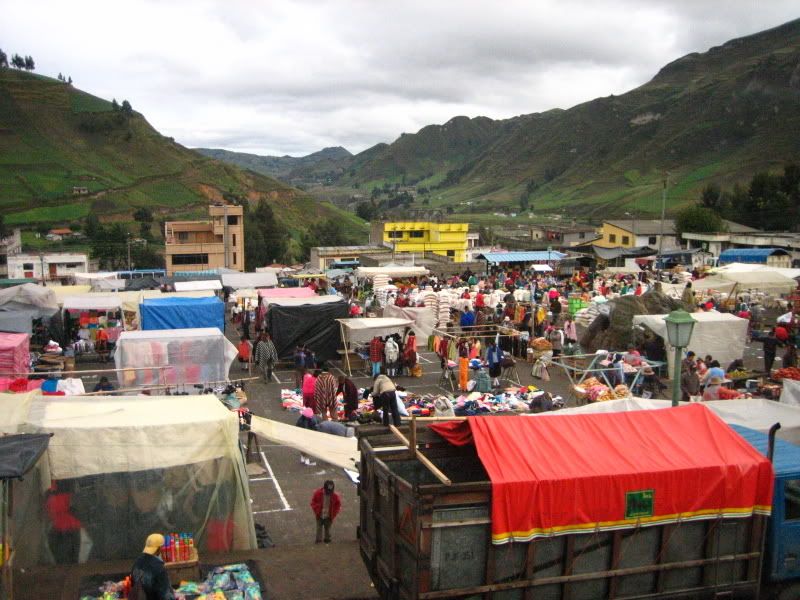
4 comments:
You can get used tombstones? I wonder how common 'Stuart Holden' is in South America. I'd still have to scratch out the dates and write new ones. Wait a second, someone else would be doing that, the bereaved. Jesus, talk about ungrateful children. "Let's just get a used one from the market and turn it around. Not like he'll notice." Holy hell I just had another realization. Who's pulling tombstones out of the ground and selling them? That is sick.
hah - 50 cent bus that's just about to leave. Bad ass
wait, not cents. What's the currency?
stu, they weren´t used... they were new and pretty damn cool...
but you did make us laugh :)
marcus, you should actually see the busses here, fitty woulnt be caught dead in one... they are sweet... we should do a bus update only about the busses...
Ohhh, only the clothing and tires were used. I see what you did there.
Post a Comment